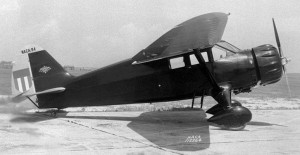One of my blog post series about my grandfather’s aviation pioneering life is “Where In The World… On This Day”… because he left such an awesome, museum-quality collection of documents, photos, logs, articles, memos, letter, photos and more that I can track where he was on a given day. Like today, for instance.
76 years ago, on May 16th, 1937, Tip was beating the Sunday sunrise at Clover Field, Santa Monica, California. He was running pre-flight checks on a Lycoming Stinson, registration number NC-13843. I know this from his pilot’s log, which he not only kept in great detail, but he had it notarized and signed off with each new flight certification. At age 24, he was aiming for a career as commercial pilot and he needed this flying time to count.
He would eventually go far beyond the career of a commercial pilot. He would become the Director of the South American Office of the International Civil Aviation Organization – and more. The story of his life, including his flights out of Clover Field, is told in his own words, as well as with my background, in “When No One Else Would Fly,” soon to be available on Amazon.com.
The Lycoming Stinson that Tip was flying that day was a day hire. Tip often flew passengers, flight students, or business men needing fast transport out of Los Angeles. Or he traded flight time with local fleet operators, but he flew almost every day. In this way, Tip flew every model of aircraft that was commonly available on 1937 civil aviation airfields, and some that were not so common.
The Lyoming Stinson was also known as the “Reliant.” It was a tail dragger, meaning that until the pilot had enough runway speed to take off, his view out the windshield was of everything except the ground in front of him. The airplane had a single overhead wing, and one engine on the nose. It could carry two passengers in addition to the pilot. True to its name, it was reliable and rugged.
“Lycoming” refers to the engine, and “Stinson” was the aircraft’s maker. This common standard for referencing aircraft in Tip’s day illustrates how important the two pieces of information were to pilots like Tip. The engine and the aircraft were two separate entities, and Tip knew them both intimately well.
Clover Field was the flight testing base of the Douglas Aircraft Company, and the maiden runway for the Douglas DC-3. Tip also knew that aircraft and company well, as they provided his day-job when he wasn’t flying overhead… as he did on Sunday, May 16th 1937.
« How Does Amazon Sales Ranking Relate to Monthly Book Sales? “When No One Else Would Fly” is now available at Amazon.com »



